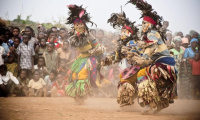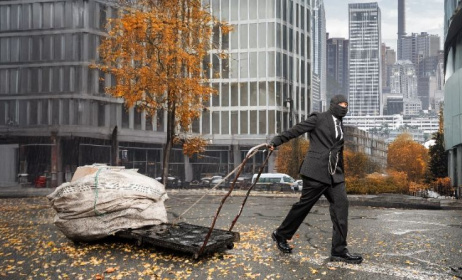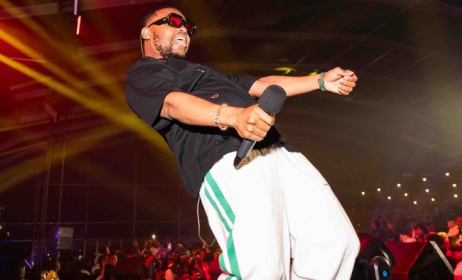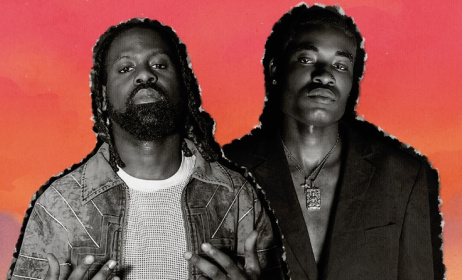The story of Kenyan hip hop and how an Englishman made Kenyans rap in Swahili
The early 1990s were tough times for Kenya, as a momentous political development that shaped the present political scene was reached. Kenya’s second president, Daniel arap Moi, was facing both local and international pressure to allow multi-party democracy, which was finally achieved in 1991.
 An early photograph of Nairobi-based hip hop trio Kalamasha.
An early photograph of Nairobi-based hip hop trio Kalamasha.
But Kenyans could still not fully enjoy freedom of expression. In 1992, a rapper named MC Core Love wrote the song ‘IPK IPK’ at the height of violent street protests in Mombasa, which were calling for the registration of the Islamic Party of Kenya (IPP), led by the fiery preacher Sheikh Balala. When the rapper’s father heard about the song, he stormed Madebe Studio in Mombasa and made sure that it was erased from the master tape.
Madebe Studio was the first well-equipped recording studio in the coastal part of Kenya where rap music evolved. It was owned by an Englishman named Andrew Burchell, a music journalist from Birmingham. The locals would later call him Madebe, a nickname given to someone who loves to dance. At the time of his arrival, Kenyan rappers were emulating American hip hop and Jamaican dancehall but Burchell challenged the rappers to abandon the English lyrics for Swahili or other local languages. “I would push them to go in a certain direction with their music because they were not paying for the studio after all. These were all hustlers so I had some leverage over them,” he was quoted as saying.
Poxi Presha, an MC who was known for covering songs by Shabba Ranks in Mombasa, is credited as one of the pioneers of Kenyan hip hop. He was also the first rapper to record a song in a vernacular language. That song, ‘Dhako’ (Woman), is a tale in the Luo language about a stubborn woman who causes embarrassment to her husband because of her behaviour. There was a huge response to the song, which was spread around Kenya by fans who might not necessarily have understood the lyrics but discovered a deep love for local hip hop.
Kalamashaka was another popular group at the time. The group sung in Swahili ghetto slang. This new wave of artists proudly represented their neighbourhoods, which were notorious for crime and high levels of poverty. At the time of Kalamashaka’s growing popularity, Kenya was in a state of rage where police brutality was common and corruption rife. AIDS was consuming households nationwide without discriminating on the basis of age; young and old perished. Socially conscious music and courageous lyrics captured the frustrations of the nation and opened up the Kenyan music industry to a new audience.
Comprising Kama (real name Ngige Ngugi), Johnny (John Vigeti) and Otero (Robert Matumbai), Kalamashaka’s hardcore style of rap spoke about the consequences of crime, drugs and guns in the ghetto. Couched in the language of Nairobi’s streets, the group’s music raised hope for a better tomorrow. In 1997, Kalamashaka recorded the ground-breaking track ‘Tafsiri Hii’ from the album Kenyan, The First Chapter.
Ukoo Flani was also among the first hip hop groups in Kenya. The crew used the political ideology of Che Guevara and Fidel Castro to create a message meant to provoke those who were oppressing ordinary Kenyans. The group was started in Mombasa by Nguchi P, RIC, Alai K, Sharama, POP, Labalaa, Chizen Brain, Shaolin, Dr Dunga and Fujo Makelele. Ukoo Flani recorded their first single ‘Ndani ya Mombasa’ at Madebe Studio in 1997. The group’s size rose to 24 members after relocating to Nairobi in 2002, with members from virtually every community taking part in the project.
Kenyan rap has come a long way since the ‘90s when the genre was used by activists and iconoclasts to express their frustration. Today, hip hop, like elsewhere in the world, has largely sided with pop and its content has shifted to the more superficial side of things. Nonetheless, Kenyan hip hop is a force on the African continent with artists like Octopizzo, Juliani and Khaligraph Jones continuously redefining the genre.



























Comments
Log in or register to post comments